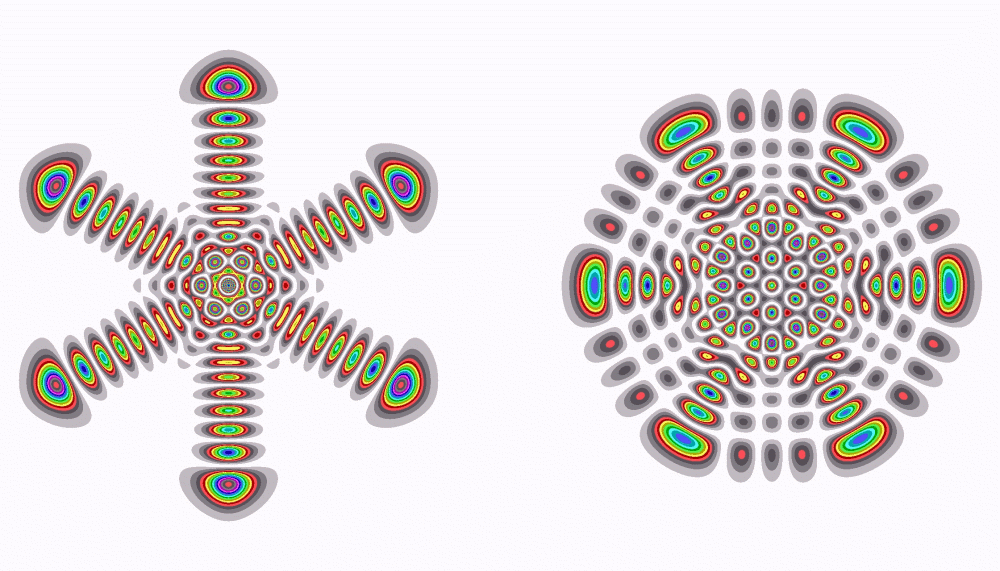
 |
 |
Physics 3C03, Spring 2012 (not offered in 2013)
Analytical Mechanics
 |

|
 |

From D. Bukta, G. Karl and B.G. Nickel,
"The Linear Baryon", Can. J. Phys. 78 (2000) 449.
Shown are probability densities of two excited states of the baryon,
which bear close resemblance to classical periodic orbits in a
hexagonal potential well.
|

|
Lectures: Mon. 16:30, Wed. 16:30, Thurs. 16:30 Term II,
Room: HH/102
Instructor: Dr. D.H.J. O'Dell
Office: ABB 320
Office Hours: Monday 10:30am-12:30pm
Email:
dodell@mcmaster.ca
Main Text: I have chosen the following book:
Classical Mechanics (Fifth Edition),
T.W.B. Kibble and F.H. Berhshire, Imperial College Press,
ISBN: 978-1860944352
Other reference books:
Theoretical Mechanics of Particles and Continua,
A.L. Fetter and J.D. Walecka, Dover Publications,
ISBN: 0486 43261 0
Classical Mechanics (Third edition),
H. Goldstein, C. Poole and J. Safko, Addison-Wesley, ISBN: 0201 65702 3
Chaos and Integrability in Nonlinear Dynamics,
Michael Tabor, Wiley, ISBN: 978-0471827283
Mechanics - from Newton's laws to deterministic chaos
F. Scheck, Springer, ISBN: 3540 21925 0 (fourth edition)
Introduction to Dynamics, Ian Percival and Derek
Richards, Cambridge University Press, ISBN: 0521 28149 0
|
Course Objectives
This course is a sequel to Physics 2D03, 2E03. Classical Mechanics
began with Isaac Newton, and for two centuries it was one of the
glories of physics. Many famous people including Euler, Lagrange,
Laplace, Gauss, Cauchy, Hamilton and Stokes contributed to the
development of analytical methods which give deep insight into the
motion of mass under the influence of applied forces. My aim is to
introduce you to some of these methods and the insights that they
offer.
During the last part of the twentieth century, the study of classically
chaotic systems lead to new insights into the question of stability of
motion.
While quantum mechanics has displaced classical mechanics as a
fundamental theory, the problem of the relation between the two remains
a subject of active research. Knowledge of advanced dynamics is a
prerequisite for a deep understanding of this relationship.
Students in Mathematics and Physics are welcome to take this course. Please
email me to get permission to enrol.
The Course outline is
available here as a .pdf file.
Here also is a list of Lecture topics for
the current year, and as it was offered in 2010:
Lecture topics from 2010
Some short biographical information
is available here; and even more here
. Also, a short note concerning W. R. Hamilton.
, as well as a picture of the man.
Some notes concerning Contact transforms
are available here, as well.
Course Work
There will be four or five marked homework assignments, plus a midterm
and a final exam. The tentative schedule is on the Course work page.
Evaluation
Your course mark is composed as follows: homework 10% , midterm 30%,
final exam 60%.
A mark of 50 % in the one of the exams is required to pass the course.
In the event that your midterm mark is higher than the final exam mark,
I will consider a more equal weighting of the two.
The assignments are an important part of the learning experience. Although they
have a low weight in the final course mark, how many assignments you completed
will be taken into account in setting the final grade.
Homework and Test Schedule
Assignment 1: Due Thursday, January 19
Assignment 2: Due Friday, February 2
Assignment 3: Due Monday, February 27
Midterm: Friday March 9, 6:30-8:30 p.m. in ABB 166
Assignment 4: Due Monday, March 19
Assignment 5: Due Monday, April 2
Final Exam: scheduled by the Registrar's Office.
See page 3 for details.
Homework assignments will be posted on the web ten days to two weeks
before the due date. This schedule is tentative. I reserve the right to
shift the above dates as the course progresses.
Statutory Notices: Academic Dishonesty
Academic dishonesty consists of misrepresentation by deception or by
other fraudulent means and can result in serious consequences, e.g. the
grade of zero on an assignment, loss of credit with a notation on the
transcript (notation reads "Grade of F assigned for academic
dishonesty"), and/or suspension or expulsion from the university. For
information on the various kinds of academic dishonesty please refer to
the
Academic Integrity and Academic Dishonesty section of your
Undergraduate Calendar.
The following are just three examples of academic dishonesty: 1)
plagiarism, e.g. the submission of work that is not one's own or for
which credit has been obtained; 2) improper collaboration in group
work; 3) copying or using unauthorized aids in tests and examinations.
In plain language this means that assignments have to be the result of
individual work.
CAP Prize Exams of recent years
2007 ,
2006 ,
2005 ,
2004 ,
2003 ,
2002 ,
2001 ,
2000 ,
1999 ,
1998 ,
1997 ,
1996 ,
1995
Coaching sessions for the CAP Prize Exam are organized by the
Physics Club. Contact Caroline Burgess if you are interested.
Site Navigation
If you want to switch to a specific page, click on the keywords either
on the left side of the page or on the bottom.
[ Overview
] [ Lecture Notes ] [ Course
Work ]
|
 |

